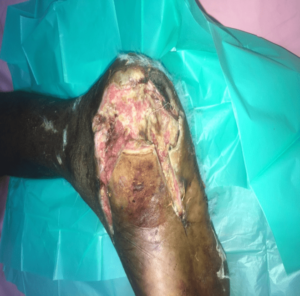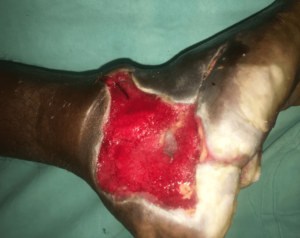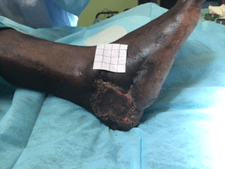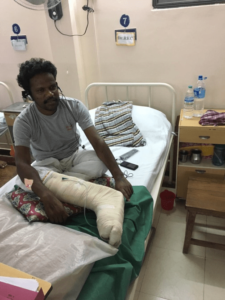INTRODUCTION
India is the world capital for diabetes mellitus. Diabetic foot ulcers (DFU) are the most costly and devastating complication of diabetes mellitus which affects 15% diabetic patients in their lifetime.1 Early effective management can reduce the severity of complications such as preventable amputations and reduce the mortality. More than 50% of non-traumatic lower-extremity amputations are related to diabetic foot ulcer infections and 85% of all lower-extremity amputations in patients with diabetes are preceded by an ulcer; up to 70% of diabetic patients with a DFU-related amputation die within 5 years of their amputation.2 Together with achieving strict glycemic control, thorough wound debridement in combination with other modalities of treatment such as advanced dressings, off loading technique, Negative pressure wound therapy are an integral part of diabetic ulcer management.1 Music therapy is one of the adjunct modality of therapy that has shown promise in relieving pain and helped in emotional and physical healing and wellbeing of the patient. In addition music permits the patient to be involved in the treatment; music can be adapted to each individuals need and can be used to distract the patient during painful procedures and experiences with the hope that they will experience decreased levels of pain. Here we describe a case of diabetic ulcer in the management of which music therapy was used as an adjunct.
CASE PRESENTATION
This study was conducted in the Department of Plastic Surgery in a tertiary care hospital during February to March 2019. An informed consent was taken from the subject under study who was a 38-year-old male, manual laborer, recently detected with diabetes mellitus who presented with ulcer over right foot of 2 months duration (Figure 1). At presentation the wound was infected and the patient had very poor glycemic control, his HbA1c being 11.8. Wound debridement was done and antibiotics were started according to culture sensitivity. In the course of the treatment, strict glycemic control was achieved with the use of insulin and oral hypoglycemic agents. Wound bed preparation was done with multiple surgical debridements (Figure 2). In addition to this, music therapy was used as an adjunct treatment. Patient was made to listen to music of his own choice daily for a period of 10 minutes, three times a day. His usual preferences were Tamil cinematic music and Carnatic music (Figures 3 and 4). Patient was also made to listen to music during dressing and wound debridement sessions. Debridement and dressings were carried out in operation theatre under local anesthesia and music of patients liking was played in a portable music device connected to patient’s earphone. Debridement and dressings were done every 3rd day according to unit protocol, with and without music therapy alternatively. Data was collected after every debridement and dressing change both when music therapy was used and without using music therapy. Patients pulse rate and blood pressure were recorded after every dressing change with or without music therapy. The mean values of pulse rate and blood pressure were recorded and mean standard deviation was calculated.
Figure 1. Diabetic Foot Ulcer at Presentation

Figure 2. After Wound Bed Preparation

Figure 3. After Reconstruction with SSG

Figure 4. Session of Music Therapy

Feedback was collected from the patient regarding how he felt when he listened to the music, whether it helped him in decreasing his pain and alleviating stress and anxiety, whether it helped in easing his discomfort during dressing and debridement sessions.
Wound bed preparation was done for a period of 3 weeks, music therapy was continued all throughout and split thickness skin grafting at the wound site was done. The study was conducted on descriptive basis and only descriptive analysis was done.
RESULTS
Music therapy was found to play an effective role as an adjunct in diabetic wound management. It helped in relieving anxiety and stress associated with wound debridement and dressings. Slight decrease in blood pressure and pulse rate was noted when debridement and dressings were done with music therapy (Tables 1 and 2).
| Table 1. Assessment of Parameters without Music Therapy |
|
Week 1 (Debridement 1) |
Week 2 (Debridement 1) |
Week 3 (Debridement 1) |
| Pulse Rate (Mean (Standard Deviation)) (bpm) |
109.2 (+/- 2) |
107.4+/-4 |
107.4+/-4 |
| Mean Systolic Blood Pressure (Mean+/-SD) (mmHg) |
114.8+/-3 |
114.2+/-3 |
112.2+/-2 |
| Mean Diastolic Blood Pressure (Mean+/-SD) (mmHg) |
84.8+/-5 |
87.4+/-6 |
82.2+/-4 |
| Table 2. Assessment of Parameters with Music Therapy |
|
Week 1 (Debridement 2) |
Week 2 (Debridement 2) |
Week 3 (Debridement 2) |
| Pulse Rate (Mean (Standard Deviation)) (bpm) |
101.4+/-2 |
91.4+/-6 |
87.7+/-6 |
| Mean Systolic Blood Pressure (Mean Standard Deviation) (mmHg) |
102.8+/-3 |
103.4+/-3 |
111.4+/-3 |
| Mean Diastolic Blood Pressure(Mean Standard Deviation) (mmHg) |
79+/-2 |
79.4+/-4 |
78+/-4 |
DISCUSSION
Diabetic Foot Ulcers (DFUs) cause morbidity and frequent visit to healthcare professionals and may lead to lower extremity amputation.3 A multimodality approach is recommended to address potential underlying problems. Proper clinical examination and shoe gear, gait, orthopaedic, neurologic, and vascular exams are also recommended. Appropriate offloading and continuing diabetes education are also an important aspect included in the treatment for all DFUs.4
Music therapy has been used as an adjuvant for healing and symptom management. Listening to music affects multiple physiological parameters including autonomic nervous system.5 Bradt et al6 reviewed the evidence for music therapy with cancer patients and concluded that music therapy may have beneficial effects on anxiety, pain, quality of life, heart rate (HR), respiration rate (RR), and blood pressure (BP) in cancer patients.6 Acute stress can activate the immune system and cause inflammation through the complement cascade.7 On the other hand, chronic stress can impair immune function and delay wound healing.8 It is important that when people are in a state of healing their immune systems are functioning optimally. Therefore, environmental stress should be kept to a minimum.5
Music therapy also helps in building better interpersonal communication between patient and healthcare workers. As a preliminary work, the authors of this study have designed and carried out this study to find out the role of music therapy as an adjunct in the management of diabetic foot ulcers. Based on feedback from patient and positive outcome, author feels that there is a positive association between the effects of music therapy as an adjunct in management of DFUs. There are limitations in the present study as it’s a single centre study performed on one subject with no control, comparison, randomisation and statistical analysis. The music used was of the subjects liking which may not be appropriate for another person. The type of music and its various aspects such as pitch, rhythm, dynamics, etc. were not studied in detail.
CONCLUSION
This is a preliminary study to find the effect of music therapy as an adjunct treatment in the management of diabetic foot ulcers. A positive effect was found but a large multi-centric double-blind, control study with statistical analysis is recommended to substantiate the result of this study.
CONSENT
The authors have received written informed consent from the patient.
CONFLICTS OF INTEREST
The authors declare that they have no conflicts of interest.









